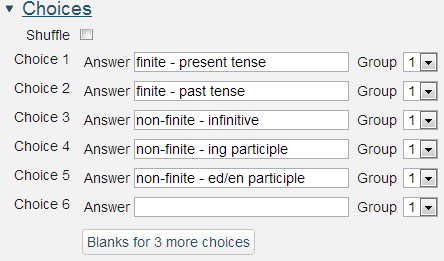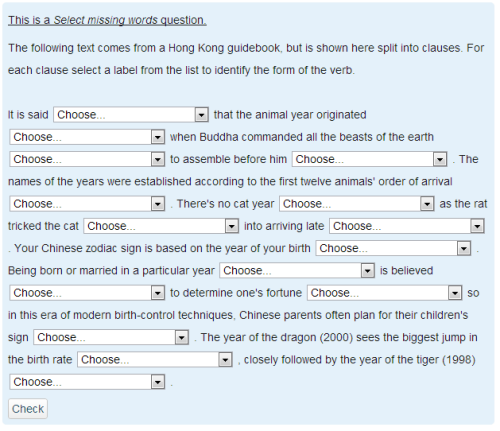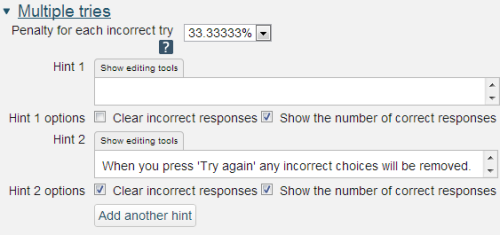2.3.6 Select missing words
The Select missing words question type is very similar to the Drag and drop words into text question type. It is useful for questions where the on-screen space is insufficient to provide space for both the question and the drag items – if the drag items are off-screen it’s rather hard to drag them anywhere.
This question type will therefore most likely be used when the question author has a large text that they wish the student to label or complete by selecting missing words from a drop-down list. Though, of course, some authors might prefer to use it to the drag and drop alternative.

Question name: A descriptive name is sensible. This name will not be shown to students.
Question text: You may use the full functionality of the editor to state the question.
The Question text is written with two sets of square brackets '[[n]]' indicating the positioning of gaps and a number 'n' inside the brackets indicating the correct choice from a list which follows the question.
General feedback: We recommend the correct answer be included in this box. Students who did not answer completely correctly can then compare and contrast to see where they made an error. The contents of this box will be shown to all students irrespective of whether their response was correct or incorrect.

Answer: Unlike the Drag and drop words into text question type the Select missing words question allows no formatting of the words to be selected.
Group: Choices that are within the same Group appear in the same drop-down lists.
The resulting question when run in 'interactive with multiple tries' style looks as follows:

Accessibility
Missing words questions are keyboard accessible. Use the
Scoring
All gaps are weighted identically. Only gaps that are filled correctly gain marks. There is no negative marking of gaps that are filled incorrectly.

Whether or not Combined feedback is shown to students is governed by the Specific feedback setting on the iCMA definition form.

Penalty for each incorrect try: The available mark is reduced by the penalty for second and subsequent tries. In the example above a correct answer at the second try will score 0.6666667 of the available marks and a correct answer at the third try will score 0.3333334 of the available marks.
If the question is used in 'interactive with multiple tries' style the marking is modified as follows:
- The mark is reduced for each try by the penalty factor.
- Allowance is made for when a correct choice is first chosen providing it remains chosen in subsequent tries.
Hint: You can complete as many of these boxes as you wish. If you wish to give the student three tries at a question you will need to provide two hints. At runtime when the hints are exhausted the question will finish and the student will be given the general feedback and the question score will be calculated.
Clear incorrect responses: When ‘Try again’ is clicked incorrect choices are cleared.
Show the number of correct responses: Include in the feedback a statement of how many choices are correct.
2.3.5 OU multiple response
